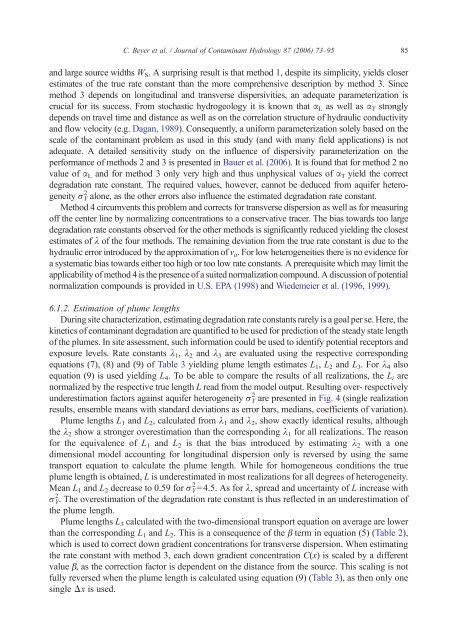Applied numerical modeling of saturated / unsaturated flow and ...
Applied numerical modeling of saturated / unsaturated flow and ...
Applied numerical modeling of saturated / unsaturated flow and ...
You also want an ePaper? Increase the reach of your titles
YUMPU automatically turns print PDFs into web optimized ePapers that Google loves.
C. Beyer et al. / Journal <strong>of</strong> Contaminant Hydrology 87 (2006) 73–95<br />
<strong>and</strong> large source widths WS. A surprising result is that method 1, despite its simplicity, yields closer<br />
estimates <strong>of</strong> the true rate constant than the more comprehensive description by method 3. Since<br />
method 3 depends on longitudinal <strong>and</strong> transverse dispersivities, an adequate parameterization is<br />
crucial for its success. From stochastic hydrogeology it is known that αL as well as αT strongly<br />
depends on travel time <strong>and</strong> distance as well as on the correlation structure <strong>of</strong> hydraulic conductivity<br />
<strong>and</strong> <strong>flow</strong> velocity (e.g. Dagan, 1989). Consequently, a uniform parameterization solely based on the<br />
scale <strong>of</strong> the contaminant problem as used in this study (<strong>and</strong> with many field applications) is not<br />
adequate. A detailed sensitivity study on the influence <strong>of</strong> dispersivity parameterization on the<br />
performance <strong>of</strong> methods 2 <strong>and</strong> 3 is presented in Bauer et al. (2006). It is found that for method 2 no<br />
value <strong>of</strong> αL <strong>and</strong> for method 3 only very high <strong>and</strong> thus unphysical values <strong>of</strong> αT yield the correct<br />
degradation rate constant. The required values, however, cannot be deduced from aquifer heterogeneity<br />
σY 2 alone, as the other errors also influence the estimated degradation rate constant.<br />
Method 4 circumvents this problem <strong>and</strong> corrects for transverse dispersion as well as for measuring<br />
<strong>of</strong>f the center line by normalizing concentrations to a conservative tracer. The bias towards too large<br />
degradation rate constants observed for the other methods is significantly reduced yielding the closest<br />
estimates <strong>of</strong> λ <strong>of</strong> the four methods. The remaining deviation from the true rate constant is due to the<br />
hydraulic error introduced by the approximation <strong>of</strong> va. For low heterogeneities there is no evidence for<br />
a systematic bias towards either too high or too low rate constants. A prerequisite which may limit the<br />
applicability <strong>of</strong> method 4 is the presence <strong>of</strong> a suited normalization compound. A discussion <strong>of</strong> potential<br />
normalization compounds is provided in U.S. EPA (1998) <strong>and</strong> Wiedemeier et al. (1996, 1999).<br />
6.1.2. Estimation <strong>of</strong> plume lengths<br />
During site characterization, estimating degradation rate constants rarely is a goal per se. Here, the<br />
kinetics <strong>of</strong> contaminant degradation are quantified to be used for prediction <strong>of</strong> the steady state length<br />
<strong>of</strong> the plumes. In site assessment, such information could be used to identify potential receptors <strong>and</strong><br />
exposure levels. Rate constants λ1, λ2 <strong>and</strong> λ3 are evaluated using the respective corresponding<br />
equations (7), (8) <strong>and</strong> (9) <strong>of</strong> Table 3 yielding plume length estimates L1, L2 <strong>and</strong> L3. Forλ4 also<br />
equation (9) is used yielding L4. To be able to compare the results <strong>of</strong> all realizations, the Li are<br />
normalized by the respective true length L read from the model output. Resulting over- respectively<br />
underestimation factors against aquifer heterogeneity σY 2 are presented in Fig. 4 (single realization<br />
results, ensemble means with st<strong>and</strong>ard deviations as error bars, medians, coefficients <strong>of</strong> variation).<br />
Plume lengths L 1 <strong>and</strong> L 2, calculated from λ 1 <strong>and</strong> λ 2, show exactly identical results, although<br />
the λ2 show a stronger overestimation than the corresponding λ1 for all realizations. The reason<br />
for the equivalence <strong>of</strong> L1 <strong>and</strong> L2 is that the bias introduced by estimating λ2 with a one<br />
dimensional model accounting for longitudinal dispersion only is reversed by using the same<br />
transport equation to calculate the plume length. While for homogeneous conditions the true<br />
plume length is obtained, L is underestimated in most realizations for all degrees <strong>of</strong> heterogeneity.<br />
Mean L1 <strong>and</strong> L2 decrease to 0.59 for σY 2 =4.5. As for λ, spread <strong>and</strong> uncertainty <strong>of</strong> L increase with<br />
σ Y 2 . The overestimation <strong>of</strong> the degradation rate constant is thus reflected in an underestimation <strong>of</strong><br />
the plume length.<br />
Plume lengths L3 calculated with the two-dimensional transport equation on average are lower<br />
than the corresponding L1 <strong>and</strong> L2. This is a consequence <strong>of</strong> the β term in equation (5) (Table 2),<br />
which is used to correct down gradient concentrations for transverse dispersion. When estimating<br />
the rate constant with method 3, each down gradient concentration C(x) is scaled by a different<br />
value β, as the correction factor is dependent on the distance from the source. This scaling is not<br />
fully reversed when the plume length is calculated using equation (9) (Table 3), as then only one<br />
single Δx is used.<br />
85

















